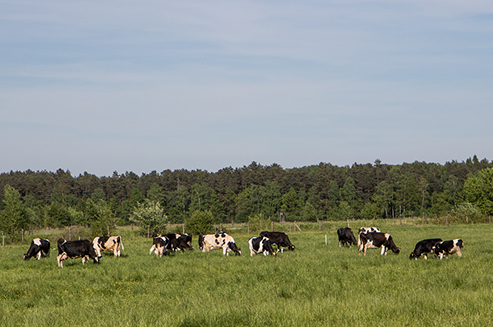Regardless of the fact that CETA takes effect provisionally, it is important to address that there will be issues considered regarding trade and relations between Europe (including Poland and other Eastern European states) and Canada.
In terms of agricultural sector, the most vulnerable commodities are considered to be beef and meat products, for European side, and dairy products (such as cheese and yoghurt), for Canadian side. During the final months of negotiations, between CETA agreement was officially presented on September 25, 2014 and was signed on October 30, 2016, several amendments were included to protect these domestic sectors of domestic agricultural industries on both sides.
In fact, to limit the dairy and meat imports on bilateral level, the amended CETA agreement has imposed the quotas varied on commodity product and on the year after the date of provisional implementation.
Dairy Products [1,2,3]
Despite that CETA would increase milk exports up to 128% and Canada will eliminate its tariff on milk protein concentrates, as well as the EU lifts its dairy tariff lines upon, cheese products perhaps remains the most challenging of all the Canadian agricultural commodities. As the European industries are more remarkable competitors in this type of commodity, free trade CETA brings a lot of risks for Canadian cheese firm to get bankrupted. According to the Dairy Processors Association of Canada estimates CETA could result in annual losses of over $230 million for cheese processors and in parallel to a $719 million loss for the overall economy and approximately 2,900 of job losses. In addition, Canada does not have any significant customer to sell its dairy products without tariffs. It is important to mention that the US President Donald Trump has frozen ratifications of TPP free trade treaty with Pacific Nations (such as Japan) by the USA’s withdrawal and he can potentially push away Mexico from NAFTA agreement.
It is also important to mention that challenges still persist. As CETA has only taken effect, it is expected that Canadian government would face more complaints from farmers during the free trade experiment. In addition, it is important to note that support funds do not have enough wealth to support all the areas. For example, if Canada refuses from US imports of diafeltered products then it must spend around 100 million Canadian dollars on that process and it takes a significant part of overall current support budget.
For example, in the first year, Canada for the EU a new bilateral quota of 18,500 tonnes of cheese, including 16,000 tonnes of which are for high quality cheeses, 1700 tonnes for industrial cheese, and in addition 800 tonnes of high quality cheese added through WTO regulations. (The quotas implemented for both standard and high quality cheese in years since 2017, check tables below):
| Cheese Tariff Quotas / Year
|
Agreement Annual Quantity (Metric tonnes) |
| 1 | 2667 |
| 2 | 5333 |
| 3 | 8000 |
| 4 | 10667 |
| 5 | 13333 |
| 6 (and each subsequent year) | 16000 |
| Industrial Cheese Tariff Quotas / Year
|
Agreement Annual Quantity (Metric tonnes) |
| 1 | 283 |
| 2 | 567 |
| 3 | 850 |
| 4 | 1133 |
| 5 | 1417 |
| 6 (and each subsequent year) | 1700 |
In addition, to protect Canadian dairy products (including cheese and yoghurt), vulnerable of free-trade competition with the EU, Justin Trudeau’s government implemented fund of 350 million dollars to support Canadian dairy industry. Of these, $250 million program would support farms to upgrade technology and equipment in order to boost productivity, which include robotic milking equipment, automated feeding systems and new herd management software. The remaining $100 million is spent for modernization of dairy processors would be available to modernize their functions and operations. In case if this find will make Canadian dairy industry more competitive on international scale, the tariff quotas on cheese products can be potentially permanently lifted, in the future.
| Industrial Tariff of Dairy Production | |||
| 2106.90.32 | Milk, cream or butter substitutes and preparations suitable for use as butter substitutes: Milk, cream or butter substitutes, containing 50% or more by weight of dairy content, over access commitment | 212% but not less than $2.11/kg | E |
| 2106.90.34 | Milk, cream or butter substitutes and preparations suitable for use as butter substitutes: Preparations containing more than 15% by weight of milk fat but less than 50% by weight of dairy content, suitable for use as butter substitutes, over access commitment | 212% but not less than $2.11/kg |
E
E= tariff-less after immediate effect |
Beef Products [4,5]
Meat industry is considered to be vulnerable primarily for the European side. Many local farms complain on ‘market imbalance’, fearing that larger Canadian farms (300 hectares against 50 hectares), would cause Canadian beef to overtake European markets by quantity. For example, French-speaking Wallonia region in Belgium was the major cause of postponing the signing CETA agreement between the European Council President Donald Tusk and Canadian Prime Minister Justin Trudeau, from the middle of October to October 30th, 2016. Therefore, additional negotiations implemented corrective actions to impose quota tariffs on meat and beef products, in order to protect European farms from misbalanced competition.
Another specific obstacle towards Canadian meat, is European authorities prohibit genetically-modified products, which are allowed to produce in Canadian farms and meat industries. Towards European market, Canada prohibits specific drugs, which should be used for cattle.
The tables provided below demonstrate annual quantity quotas for specific beef-related products:
| Frozen or Other Beef and Veal Tariff Rate Quota in year
|
Agreement Annual Quantity (Metric Tonnes – Carcass Weight Equivalent) |
| 1 | 2500 |
| 2 | 5000 |
| 3 | 7500 |
| 4 | 10000 |
| 5 | 12500 |
| 6 (and each subsequent year) | 15000 |
| Fresh or Chilled Beef and Veal Tariff Rate Quota in year
|
Agreement Annual Quantity (Metric Tonnes – Carcass Weight Equivalent) |
| 1 | 5140 |
| 2 | 10280 |
| 3 | 15420 |
| 4 | 20560 |
| 5 | 25700 |
| 6 (and each subsequent year) | 30840 |
Polish (and Eastern European) issues towards agricultural trade [6,7]
German and other Western European meat industries still outcompete the Eastern European counterparts as it has more advanced technologies, which also make meat to produce at faster and cheaper rate.
Furthermore, agricultural products in Eastern European products still have lower quality of agricultural products than Western European counterparts.
Both issues can be potential considered in terms of competition within Canada-EU free trade process.
More information about CETA and Canada-Poland cooperation you can find on: Canada-Poland Chamber of Commerce
Read also: CETA: The Comprehensive Economic and Trade Agreement between Canada and the EU
Photo © Anna Karahan
References:
[1] McGregor, J. (2016) ‚$350M dairy programs to help farmers, processors compete under Canada-EU trade deal’. CBC, November 10. [2] Ireton, J. (2016) ‚Dairy farmers weigh pros, cons of EU-Canada trade deal’. CBC, October 28. [3] Charlebois, S. (2016) ‚OPINION: CETA trade deal good for meat sales, bad for dairy but will likely die anyway’. Farmers Forum, October 25. [4] Daily Mail (2016) ‚Hundreds in Warsaw protest free-trade deals with US, Canada’, 15 October. [5] McGregor, J. (2016) ‚EU trade deal ‚unbalanced’ against Canadian meat, industry says’, CBC, October 26. [6] Domagala-Pereira, K (2017). ‚Help for Eastern Europeans in Germany’s meat industry’, Deutsche Welle, 20 March. [7] Seiler, B. (2017) ‚Agrispeculation in eastern Europe’ . Deutsche Welle, 3 April.Tables – ‚CETA-Summary of the final negotiating results’. European Commission.



